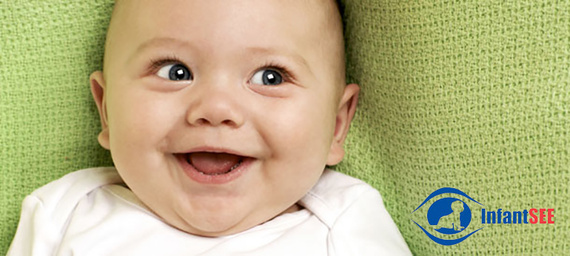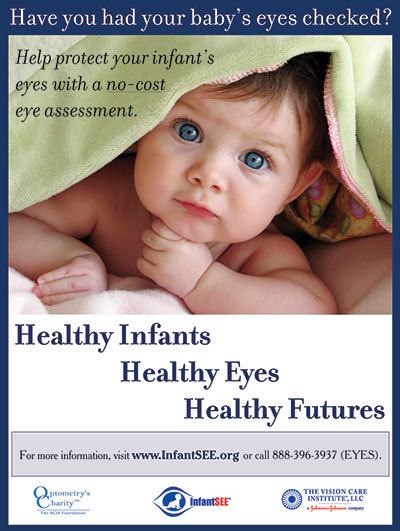Your baby's eyes developed in utero as an extension of the brain. At birth, your baby could see light and dark, but not colors or details. Outside stimuli began to interact with your newborn's eyes and vision began to form.
Vision and the way the brain uses visual information, are skills that a baby learns over time. The greatest amount of growth in vision and processing visual information occurs during your baby's first year of life. During this time, your baby will learn how to focus on an object and how to move the eyes in response to stimuli. All of these vision milestones will allow your baby to interact appropriately with the world.
The American Optometric Association (AOA) recommends that children receive their first eye assessment from an optometrist (eye doctor) between six and 12 months of age. This is a critical time for a trained professional to detect and treat eye and vision problems.
An InfantSEE® assessment will complement your child's well visits at the pediatrician's office. Many eye conditions, including amblyopia (lazy eye), muscle imbalances and some eye diseases, have no signs or symptoms. They are not detectable by the base-level infant eye screenings performed by your pediatrician during a well-baby exam.
Remember, your pediatrician checks your baby from the crown of the head to the feet during your visits. On the other hand, your eye doctor has clinical education, training and experience, as well as the instruments and resources, to provide specialized eye and vision assessments. Yet the AOA's 2015 American Eye-Q® survey reveals that only one in five parents knows that children should receive their first comprehensive assessment at this juncture from an eye doctor.
Instead of the complicated devices used for adult eye exams, your baby's eye health and vision will be tested using devices designed for infants. As infants are unable to speak at this stage of life, optometrists perform several non-invasive tests to evaluate your baby's overall eye health as well as the ability of your baby's eyes and brain to work together. An InfantSEE® assessment takes about 90 minutes at your optometrist's office. This includes waiting time for your baby's eyes to dilate so that your optometrist can get a clear view of the back of your baby's eyes.
Your baby will feel most secure and comfortable being examined the same way the two of you spend most of your time. By having your baby sitting comfortably in your lap, the optometrist will be able to easily interact with your baby, gauge your baby's comfort levels with specific techniques and adjust them if needed.
Your Baby's External Eye Health
Your optometrist will first perform an external assessment of your baby's eyes. By looking at your baby's eyelids and tear ducts, your optometrist can detect problems that may be causing your baby eye discomfort. These conditions can easily be addressed with drops or lifestyle changes that will make your baby more comfortable.
Your Baby's Vision
Your optometrist can assess your baby's visual acuity by holding a series of gray cards with various sized stripes or with pictures. These will be used to determine which objects your baby prefers to look at. The way in which your baby responds to these cards will also allow your optometrist to gauge your baby's visual response to objects at different distances.
Your Baby's Eyes and Muscles Working as a Team
Your baby's depth perception can be assessed by using special targets that appear to pop out or float if the eyes are working together as a team. Your baby will reach for the floating target confirming the ability to see in 3D. This test can be performed with or without red/green or polarized eye glasses.
Your baby will also be assessed to measure eye coordination. This is the ability of both eyes to work together as a team that creates a single 3D image in the brain. These eye coordination skills must be learned by your baby in order to keep the eyes aligned. To attract your baby's attention and test the eyes' ability to move as a team, your optometrist will observe how your baby follows the movements of an object. By shining a penlight toward the baby's eyes, the doctor can gauge eye alignment. The light will confirm the alignment of your baby's eyes by being reflected in the center of both eyes.
Dilation for a View of the Back of the Eyes
Next, the optometrist will dilate your baby's eyes in order to see the inner eye. This is a safe procedure done with gentle eye drops. Drops placed in each eye widen the pupil, which is the opening in the center of the iris, the colored part of the eye. Just as opening a door allows you to see more of the inside of a room, dilating the pupil allows the optometrist a better view of the inside of a baby's eyes.
Dilating the pupils of your baby's eyes takes some time. Once the drops are administered, dilation takes about 30 to 40 minutes. This might be a good time for a snack and a diaper change so that your baby is ready for the second part of the assessment.
Once dilated, each eye is examined using a special magnifying lens that provides a clear view of important tissues at the back of the eye. Your optometrist will look carefully at the retina (light-sensitive layers of tissue at the back of the eye) and the optic nerve, which carries information from the eyes to the brain. Examining the back of the eye will allow your optometrist to check for eye diseases including cancers such as retinoblastoma, the seventh most common pediatric cancer.
Next, your baby's eyes will be measured fornearsightedness or farsightedness. These conditions in your baby's developing eyes can send messages to the brain causing it to favor seeing through only one eye and suppressing vision in the other eye. This can lead to permanent vision impairment. These conditions are also risk factors for amblyopia, commonly known as lazy eye. This develops when an otherwise healthy eye has not received adequate use during early childhood.
Ruling Out Learning Disabilities
Many children who receive a diagnosis of learning disabled are actually suffering from eye and vision-related problems that can be detected by an InfantSEE® exam. If not detected during infancy, poor eye coordination will cause future learning difficulties for your child. If the eyes do not work together effectively, your child will experience future difficulty reading for extended periods of time or poor reading comprehension. Poor eye teaming can also result in avoidance of detail work, such as writing or art projects. Or, your child may simply demonstrate awkward or clumsy movements that are actually vision problems that can be effectively addressed by your optometrist.
If your baby did not receive an infant eye assessment, arrange for one as early as possible. It is very important to take this step and begin a lifetime of healthy vision. Vision development and eye health problems are easier to address if treatment begins early. Failure to detect and treat eye and vision conditions can impair your baby's ability to reach important developmental milestones. More than a health issue, this can create lifelong learning and social problems for your child.
After your Infant SEE® assessment, annual comprehensive eye exams for your child through age 18 are covered by the Pediatric Essential Health Benefit in the Affordable Care Act.
InfantSEE® is not just an assessment of your baby's vision, but a vision of your baby's future. Healthy eyes and vision are the key to your baby's quality of life. To find an InfantSEE® optometrist in your area visit InfantSEE.org.

